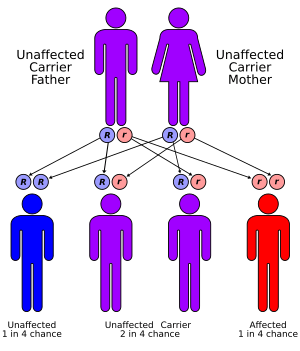Allele facts for kids
An allele is like a specific version or type of a gene. Think of a gene as a recipe for a trait, and an allele is a specific ingredient that makes that trait appear in a certain way. Each gene has a special spot on a chromosome called a locus.
Most plants and animals, including humans, get two sets of chromosomes – one from their mom and one from their dad. These living things are called diploid. Because they have two sets of chromosomes, they usually have two alleles for each gene. One allele comes from the mother, and the other comes from the father.
If an individual has two identical alleles for a specific gene, they are called a homozygote. We say they are homozygous for that gene. If their two alleles for a gene are different, they are called a heterozygote and are heterozygous.
Contents
How Alleles Show Up
Sometimes, when an individual has two different alleles (is heterozygous), one allele can completely hide the effect of the other. This means the trait you see (the phenotype) looks exactly like it would if only one of those alleles was present twice.
The allele that hides the other is called dominant. The allele that is hidden is called recessive. This idea was first discovered by Gregor Mendel, who is known as the founder of genetics.
In other cases, both alleles can contribute to the trait you see.
An Example with Flowers
We can use a tool called a Punnett square to see how alleles are passed down and how dominance works.
Let's look at the color of flowers. Imagine a single gene controls the color of the petals. There might be different versions (alleles) of this gene.
In our example, let's say the parents both have the genotype Bb. We use a capital letter (B) for the dominant allele and a lowercase letter (b) for the recessive allele. If a flower has at least one B allele, it will be red. So, the only way a flower will not be red is if its genotype is bb (meaning it has no dominant B alleles).
| Mother's Alleles | |||
|---|---|---|---|
| B | b | ||
| Father's Alleles | B | BB | Bb |
| b | Bb | bb | |
Looking at the Punnett square, here are the chances of the offspring having different genotypes:
- BB (homozygous dominant): 25% chance
- Bb (heterozygous): 50% chance
- bb (homozygous recessive): 25% chance
Since any flower with a dominant B allele will be red, there is a 75% chance of getting a red flower (25% BB + 50% Bb). There is a 25% chance of getting a flower that is not red (bb).
Recessive Alleles
The way recessive genes are inherited is quite straightforward. If an individual has one dominant allele and one recessive allele (is heterozygous), the dominant allele will determine the trait that shows up. The recessive allele will only show its trait if both alleles are recessive (if the individual is homozygous recessive).
Incomplete Dominance
Sometimes, a dominant allele isn't completely dominant over a recessive allele. This means that when both alleles are present in a heterozygote, the trait that appears is a mix or an in-between version of what each allele would produce on its own.
For example, in the Mirabilis jalapa plant (also known as the four o'clock flower), if you cross a red-flowered plant (homozygous dominant) with a white-flowered plant (homozygous recessive), the offspring (F1 generation) will have pink flowers. The pink color is an intermediate blend of red and white.
Sex-Linked Genes
Genes found on the sex chromosomes are called sex-linked genes. In humans and other mammals, the sex chromosomes are X and Y. The X chromosome carries many genes, but the Y chromosome carries very few. Alleles or genes that are not sex-linked are called autosomal genes. These are found on the other chromosomes, not the sex chromosomes.
How Alleles Can Be Different
Alleles at a specific locus can be different in a few ways:
- By origin: The two alleles in a diploid individual always come from different chromosomes – one from each parent. So, they differ by their origin.
- By state: Alleles can be different if their DNA sequences are not the same. This difference might change the amino acid sequence of a protein they code for.
Related pages
See also
 In Spanish: Alelo para niños
In Spanish: Alelo para niños


